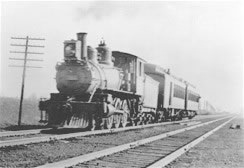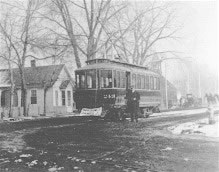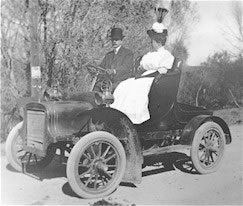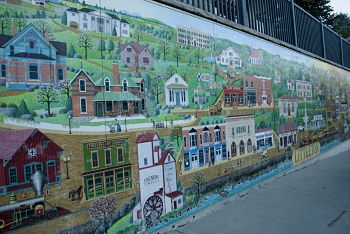History of Transportation
When the Littleton area first began to be settled in 1862, there were two principal forms of transportation available: walking, and either riding or being pulled by a horse. There were no roads to speak of, only old Native American trails which had been widened and packed hard by the increased usage of white men. This did not change for nearly a decade.
Regarding the stagecoach in Littleton, Edwin A. Bemis, editor and owner of the Littleton Independent, wrote “In the early days, that is, the stagecoach days, the trails from Kansas led from Topeka, Atchison, Ft. Leavenworth, and other places and usually came into Colorado through the area from Wray, Colorado to Kit Carson. The principal trail coming into this area was the ‘Smoky Hill Route’, but there was another one called the ‘Leavenworth and Pikes Peak Express’. When the L&PPE reached Cherry Creek, they did not follow the creek, but continued westward toward what is now Littleton. One of the old ‘59ers’ told me that this trail came into Littleton at about where Alamo Street runs, then swung northward along the east side of the Platte River into Denver.”
As farfetched as it may sound, the early South Platte valley settlements had a legacy of steamboat travel. The Rocky Mountain News regularly published the arrivals and departures of various river boats, and saw to it that major east coast newspapers reprinted them. Was the South Platte River deeper then? No. This was just one of many schemes dreamed up by News editor William Byers to boost settlement in Colorado Territory -- by the time greenhorns discovered the deception, they were in St. Louis, more than half-way here. The only "real" traffic on the South Platte, then or since, were shallow-draft barges and canoes carrying beaver and buffalo hides to Missouri markets.
Steam-powered transportation did reach Littleton in 1871, when tracks of the Denver and Rio Grande Railroad were completed to a siding at Richard Little's farm. On August 24, the engine Montezuma brought the Mayor of Denver and assorted dignitaries to the end of the line. The striking beauty of the area elicited such enthusiasm that the railroad added a public excursion two days later, a Sunday, and sold out at $2.50 for the round trip. This began a long relationship between the citizens of Denver and the "resort" community of Littleton.
Three years later, the Denver, South Park and Pacific Railroad laid tracks on the west bank of the South Platte River, putting Littleton on the most direct route to the Leadville mining district. In 1887 the Atchison, Topeka and Santa Fe pulled into town from Pueblo, joining several smaller and/or short-lived lines. In 1889, one observer along the tracks wrote, "...we counted twelve trains as they passed to and fro inside an hour. No one has any idea of the monster traffic on these two roads until they go and look for themselves." At its peak, Littleton boasted twenty-four scheduled stops a day for passengers and freight.

D. & R.G. "Uncle Sam," c.1916.
The star of the railroads was the D&RG's Uncle Sam, a special excursion between Denver and Littleton, with a stop at Fort Logan, that ran as many as six trips a day. Begun in 1888 and terminated in 1924, it was considered one of the country's finest passenger operations, and was the D&RG's most profitable route, despite a round-trip fare of just 25 cents. Between 1906 and 1923 the Uncle Sam boasted a "Theater Train" once or twice a week.
In the 1890s, during the height of railroad popularity, another transportation craze swept the country -- bicycling. Although bicycles, or velocipedes as they were originally called, had been around since the 1860s, the invention of pneumatic rubber tires and friction brakes made it a household item. Denver led the craze, boasting the highest per capita bicycle ownership in the country. Among the many popular bike paths constructed was south from Denver along the city ditch to Littleton. Once there, many cyclists picnicked in the shade surrounding the Sunshine and Shadow Inn or watched the bike races around the Inn's track, while the more adventurous continued south to Palmer Lake and back, completing a "century" ride, or 100 miles in a day.

Littleton's street car, c.1910.
The next improvement was the electric trolley car, which was extended from Denver into Littleton in 1907. The line came down south Broadway, went cross-country at Big Dry Creek to enter the town on Prince Avenue and then turned onto Main. Eventually, the line was extended across the South Platte River, south of Bowles Avenue. For a time, the Littleton route included the famous "Cherrelyn" street car on south Broadway, where a horse assisted the motors going up a steep grade, then climbed aboard and rode on the car during the descent. The streetcar line was abandoned in 1926 in favor of cheaper to run and more flexible buses.

Dr. and Mrs. Crysler in their first automobile, 1909.
The final improvement in personal transportation began just after the turn of the century and continues to today. In 1904, Rude Chandler's "benzine buggy" automobile cruised onto Littleton's streets. Within two years there were eight of the infernal contraptions buzzing about and the city was besieged by calls to license the machines and ticket those exceeding "an immoderate speed". The city responded with a speed limit for all conveyances of 8 miles an hour. Now, of course, Littletonites could hardly imagine their city without wide boulevards, super highways and the automobile.
The Southwest Light Rail Line, providing rail transportation to downtown Denver from Littleton, opened to the public on July 14, 2000, with revenue service beginning on July 17, 2000. Two light rail lines, the C and D lines, provided service to and from Littleton and downtown Denver for many years. In 2021, due to budget reductions by the Regional Transportation District, the C line (going to Union Station in Denver) was eliminated. The D line continues to run from Littleton to the downtown area.

Mural at Littleton Light Rail Station, 2015. Photo by Amelia Martinez.
Bibliography
Bemis, Edwin A. Historical Notes. Littleton, Colorado. Date unknown.
Littleton Independent. Littleton Independent Publishers, 1888-
Littleton Independent. Sixtieth Anniversary Edition, 1888-1948. Littleton: Littleton Independent Publishers, 1948.
Littleton Museum. Photographic Archives.
____. Vertical File: "Transportation".
McQuarie, Robert J. and C.W. Buchholtz. Littleton, Colorado: Settlement to Centennial. Littleton: Littleton Historical Museum and Friends of the Library and Museum, 1990.
O.L. Baskin & Co. History of the City of Denver, Arapahoe County and Colorado. Chicago: Baskin & Co., 1880.
Photographs courtesy of the Littleton Museum, unless otherwise noted; to order copies, contact the Museum at 303-795-3950.
Compiled by Pat Massengill
Updated May 2021 by Phyllis Larison